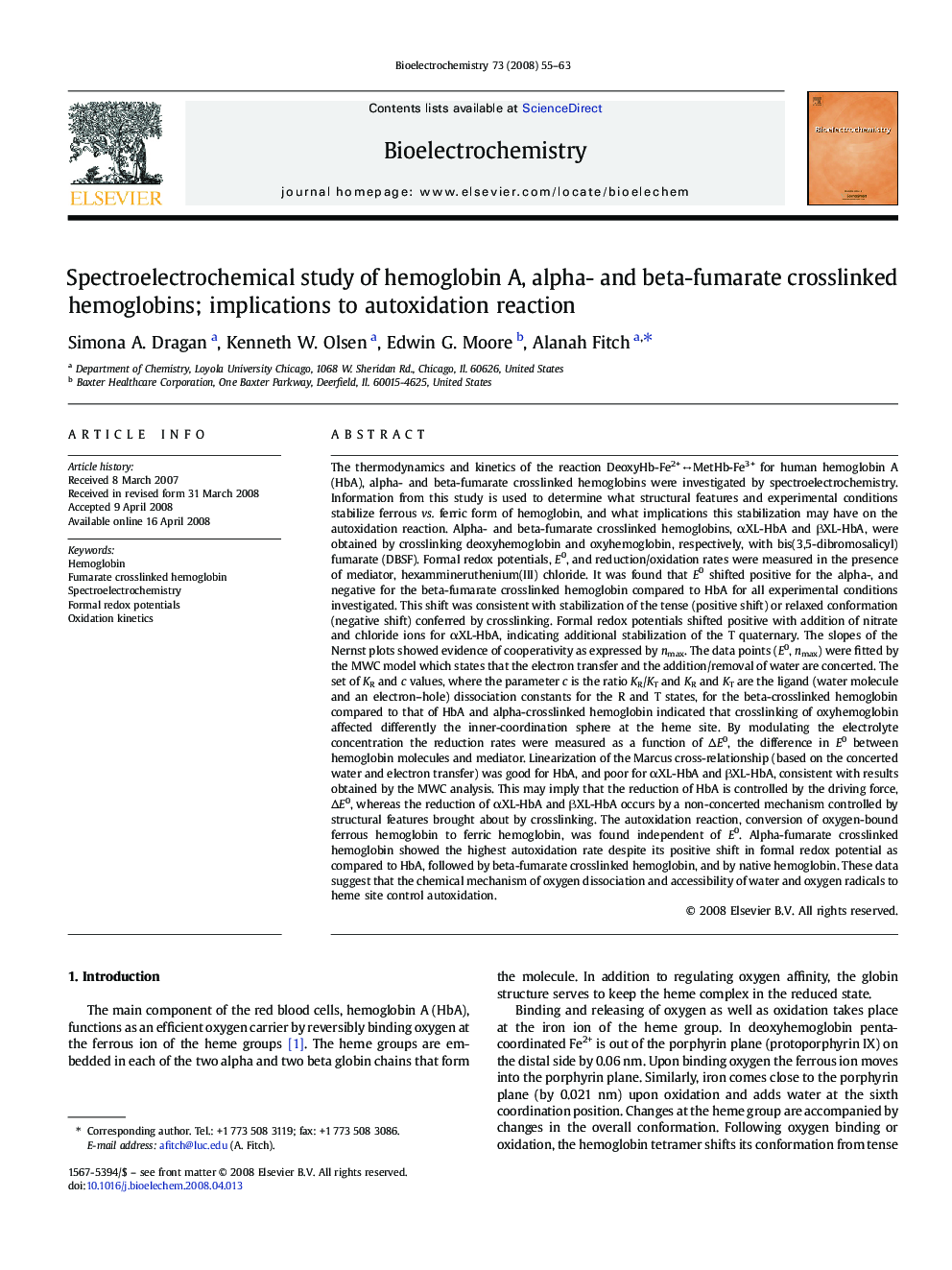| کد مقاله | کد نشریه | سال انتشار | مقاله انگلیسی | نسخه تمام متن |
|---|---|---|---|---|
| 1272291 | 972554 | 2008 | 9 صفحه PDF | دانلود رایگان |

The thermodynamics and kinetics of the reaction DeoxyHb-Fe2+ ↔ MetHb-Fe3+ for human hemoglobin A (HbA), alpha- and beta-fumarate crosslinked hemoglobins were investigated by spectroelectrochemistry. Information from this study is used to determine what structural features and experimental conditions stabilize ferrous vs. ferric form of hemoglobin, and what implications this stabilization may have on the autoxidation reaction. Alpha- and beta-fumarate crosslinked hemoglobins, αXL-HbA and βXL-HbA, were obtained by crosslinking deoxyhemoglobin and oxyhemoglobin, respectively, with bis(3,5-dibromosalicyl) fumarate (DBSF). Formal redox potentials, E0, and reduction/oxidation rates were measured in the presence of mediator, hexammineruthenium(III) chloride. It was found that E0 shifted positive for the alpha-, and negative for the beta-fumarate crosslinked hemoglobin compared to HbA for all experimental conditions investigated. This shift was consistent with stabilization of the tense (positive shift) or relaxed conformation (negative shift) conferred by crosslinking. Formal redox potentials shifted positive with addition of nitrate and chloride ions for αXL-HbA, indicating additional stabilization of the T quaternary. The slopes of the Nernst plots showed evidence of cooperativity as expressed by nmax. The data points (E0, nmax) were fitted by the MWC model which states that the electron transfer and the addition/removal of water are concerted. The set of KR and c values, where the parameter c is the ratio KR/KT and KR and KT are the ligand (water molecule and an electron–hole) dissociation constants for the R and T states, for the beta-crosslinked hemoglobin compared to that of HbA and alpha-crosslinked hemoglobin indicated that crosslinking of oxyhemoglobin affected differently the inner-coordination sphere at the heme site. By modulating the electrolyte concentration the reduction rates were measured as a function of ΔE0, the difference in E0 between hemoglobin molecules and mediator. Linearization of the Marcus cross-relationship (based on the concerted water and electron transfer) was good for HbA, and poor for αXL-HbA and βXL-HbA, consistent with results obtained by the MWC analysis. This may imply that the reduction of HbA is controlled by the driving force, ΔE0, whereas the reduction of αXL-HbA and βXL-HbA occurs by a non-concerted mechanism controlled by structural features brought about by crosslinking. The autoxidation reaction, conversion of oxygen-bound ferrous hemoglobin to ferric hemoglobin, was found independent of E0. Alpha-fumarate crosslinked hemoglobin showed the highest autoxidation rate despite its positive shift in formal redox potential as compared to HbA, followed by beta-fumarate crosslinked hemoglobin, and by native hemoglobin. These data suggest that the chemical mechanism of oxygen dissociation and accessibility of water and oxygen radicals to heme site control autoxidation.
Journal: Bioelectrochemistry - Volume 73, Issue 1, June 2008, Pages 55–63